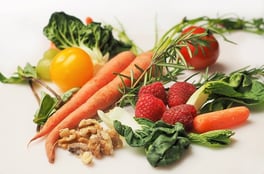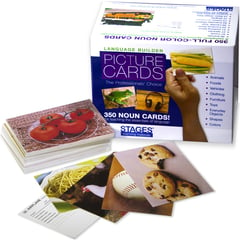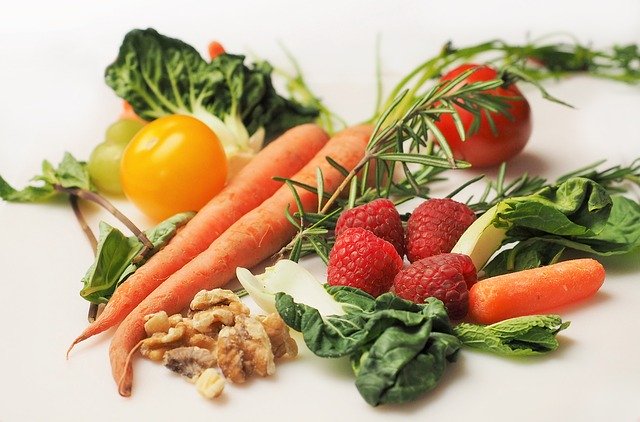Teaching Healthy Eating Choices to Children with Autism
This resource was created as a supplement for the Language Builder: Academic Readiness Intervention System (ARIS) complete early autism curriculum, Lesson #129, A Healthy Plate. Download a free copy of the lesson and learn more about the ARIS curriculum.
For children with autism, making healthy eating choices can be difficult. Children with ASD are five times more likely to have challenges with meals than their peers. It is common for them to have repetitive, ritualistic habits, which can affect eating. Children with ASD may have especially strong likes and dislikes to certain foods, relating to taste, smell, color, and texture of the item. Some children do not eat enough, due to extreme food selectivity or difficulty focusing during eating. For some children, because of their limited food choices, they experience frequent constipation or stomach pain. Medication can also affect a child’s eating habits. For example, some common stimulant medications may reduce appetite.
Eating choices can impact a child’s overall health, social life, and ability to focus. There are strategies that can be used to teach healthy eating choices and food groups to children with autism.

One way a child can be supported in learning healthy eating choices is through consistently incorporating balanced food choices into snacks, lunch, and other meals. Pretend play activities such as playing “Kitchen,” “Restaurant,” or “Grocery Store” can allow children to demonstrate their knowledge in creative ways. When foods are present in books or videos, it is another opportunity to have a discussion about the food choices presented.
 How to Play “Kitchen”
How to Play “Kitchen”
- Choose a few food items (or images of foods) that are commonly found in your kitchen.
- Choose some kitchen tools to play pretend with, such as utensils, plates, pots, pans, etc.
- Allow the child the freedom to explore with the items in the “kitchen.” Pretend to cook, bake, mix ingredients, etc. Have fun imagining that you are preparing family dinner together!
How to Play “Restaurant”
- Choose a few food items (or images of foods) that can be put together to create a meal. (For example, pasta, sauce, and salad).
- Have the child make a “restaurant menu” with the food items available, through drawing, writing, video, etc.
- Pretend to order from the “restaurant.”
- The child will have fun “putting the ingredients together” (physically, or the pictures) to serve to the restaurant-goers.
How to Play “Grocery Store”
- Choose a few food items (or images of foods) that are commonly found on a grocery list (milk, eggs, bread, etc.).
- Layout the items on a table or throughout a room.
- Practice making a “grocery list” with the child that they can use to “shop” with.
- Have the child “shop” for the items!
It is important to understand that ideas of healthy eating can differ between people, so communicating with teachers, aides, babysitters, and others what healthy eating looks like for your child is important. If your child is especially selective when it comes to food, it is okay to begin these activities with acknowledging the foods that they do eat, slowly incorporating different kinds of foods in their diets to try. Seeing the food groups visually in this activity can also help your child recognize food groups that they are not eating enough, and making a game out of introducing other food choices within that group and allowing the child to choose something new to try.
Changing Meal Time to Adapt to Your Unique Child
The kitchen at home can be a stressful: bright colors, lights, noisy. Eating anywhere outside the home kitchen can be especially stressful because it is a new, unknown place. Making meal time as routine as possible, in the same place at the same time, is an important way to reduce stress for your child. The physical kitchen can be easily adapted to be comfortable for your child. Reduced lighting (including shades), fewer items on counters, a favorite food nearby, keeping chairs and other furniture to a minimum, are all simple ways to create a more calming environment for your child at mealtimes.
Working with a dietician or nutrition can be helpful in identifying ways to improve your child’s diet, health, and monitor the nutritional value of the foods they are eating. Especially for children who are picky eaters, these specialists can be helpful.
There are many special diets that appeal to children with ASD, such as a gluten-free or casein-free diets. Not all of these diets are research-based. Before starting any kind of special diet, it is important to consult with your child’s doctors, dietitians, and nutritionists and decide what is the healthiest and safest for your child.
Additionally, while portion sizes are important, while beginning to teach healthy eating choices with your child with ASD, the first goal is recognizing which foods belong in which food groups. Empowering your child with the skills to make balanced food choices independently is an important life-long skill.
Stages Learning Materials has a new Language Builder: Academic Readiness Intervention System (ARIS for short) that uses the research-based Language Builder Picture Card sets and 3-D manipulatives with lessons that help your child learn daily living skills – such as learning to make healthy eating choices.
This article was based on the following research:
https://www.ncbi.nlm.nih.gov/pmc/articles/PMC4536585/
https://www.nichd.nih.gov/health/topics/autism/conditioninfo/treatments/nutritional-therapy
This resource was created as a supplement for the Language Builder: Academic Readiness Intervention System (ARIS) complete early autism curriculum, Lesson #129, A Healthy Plate. Download a free copy of the lesson and learn more about the ARIS curriculum.





